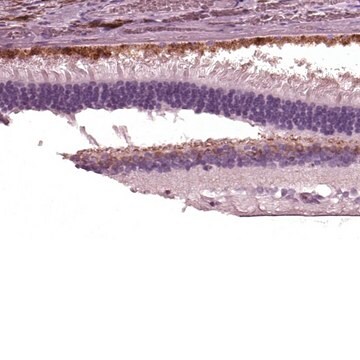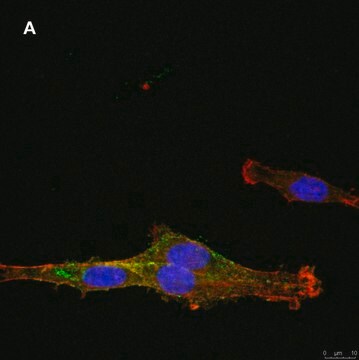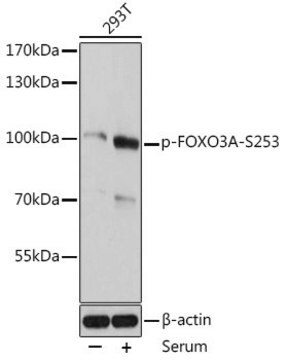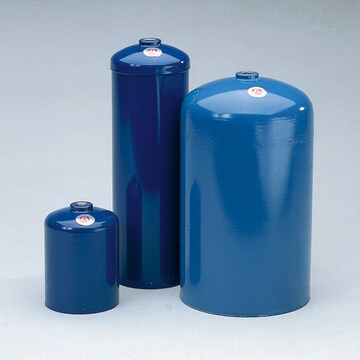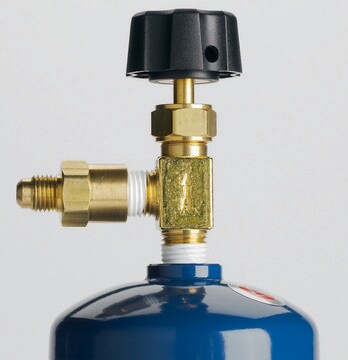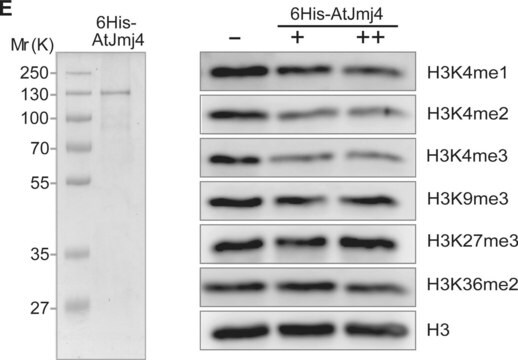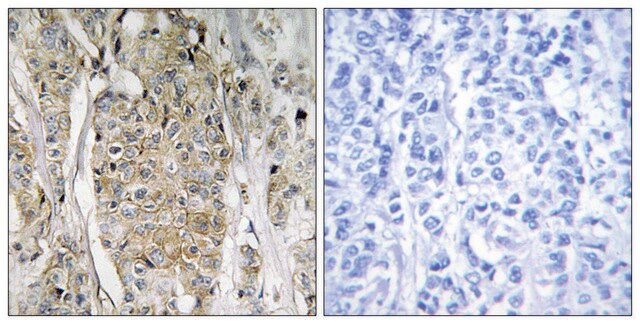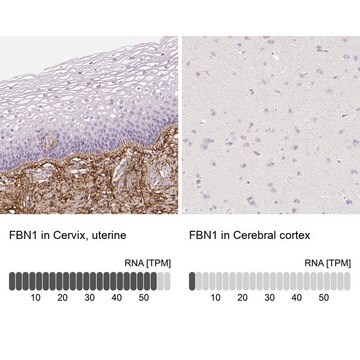おすすめの製品
由来生物
hamster
品質水準
抗体製品の状態
purified antibody
抗体製品タイプ
primary antibodies
クローン
H2C7, monoclonal
分子量
observed mol wt ~N/A kDa
精製方法
using protein G
化学種の反応性
mouse
包装
antibody small pack of 100
テクニック
immunocytochemistry: suitable
immunohistochemistry: suitable
アイソタイプ
IgG
エピトープ配列
Extracellular domain
タンパク質IDアクセッション番号
UniProtアクセッション番号
保管温度
2-8°C
遺伝子情報
mouse ... Kit(16590)
特異性
Clone H2C7 is an Armenian hamster monoclonal antibody that detects c-Kit/CD117. It targets an epitope within the extracellular domain.
免疫原
E14 mouse olfactory cortices.
アプリケーション
Quality Control Testing
Evaluated by Immunohistochemistry in E14 Mouse liver sections.
Immunohistochemistry Applications: A 1:25 dilution from a representative lot detected c-kit/CD117 in E14 Mouse liver frozen tissue sections.
Tested Applications
Immunohistochemistry Analysis: A 1:25 dilution from a representative lot detected c-Kit/CD117 in developing mouse forebrain frozen tissue sections.
Immunocytochemistry Analysis: A representative lot detected c-Kit/CD117 in Immunocytochemistry applications (Koma, Y., et al. (2005). Lab Invest. 85(3):426-35).
Immunohistochemistry Applications: A representative lot detected c-Kit/CD117 in Immunohistochemistry applications (Yamatani, H., et al. (2004). J Comp Neurol. 475(2):247-60; Takagi, K., et al. (2008). Neuroscience. 153(4):1278-88).
Note: Actual optimal working dilutions must be determined by end user as specimens, and experimental conditions may vary with the end user.
Evaluated by Immunohistochemistry in E14 Mouse liver sections.
Immunohistochemistry Applications: A 1:25 dilution from a representative lot detected c-kit/CD117 in E14 Mouse liver frozen tissue sections.
Tested Applications
Immunohistochemistry Analysis: A 1:25 dilution from a representative lot detected c-Kit/CD117 in developing mouse forebrain frozen tissue sections.
Immunocytochemistry Analysis: A representative lot detected c-Kit/CD117 in Immunocytochemistry applications (Koma, Y., et al. (2005). Lab Invest. 85(3):426-35).
Immunohistochemistry Applications: A representative lot detected c-Kit/CD117 in Immunohistochemistry applications (Yamatani, H., et al. (2004). J Comp Neurol. 475(2):247-60; Takagi, K., et al. (2008). Neuroscience. 153(4):1278-88).
Note: Actual optimal working dilutions must be determined by end user as specimens, and experimental conditions may vary with the end user.
ターゲットの説明
Mast/stem cell growth factor receptor Kit (UniProt: P05532; also known as EC:2.7.10.1, SCFR, Proto-oncogene c-Kit, Tyrosine-protein kinase Kit, CD117) is encoded by the Kit (also known as SI) gene (Gene ID: 16590) in murine species. c-Kit is a single-pass type I membrane glycoprotein that is synthesized with a signal peptide (aa 1-24), which is subsequently cleaved off to generate the mature form that contains an extracellular domain (aa 25-527), a transmembrane domain (aa 528-548), and a cytoplasmic domain (aa 549-979). c-Kit has tyrosine protein kinase activity and serves as a cell-surface receptor for the stem cell factor (SCF)/KITLG. It plays a significant role in the regulation of cell survival, cell proliferation, stem cell maintenance, gametogenesis, and other functions. In response to SCF binding, c-Kit can activate several signaling pathways. In the absence of bound SCF, it exists as a monomer, however, it homodimerizes in the presence of bound SCF and forms a heterotetramer with two SCF molecules. c-Kit can be autophosphorylated on tyrosine residues and SCF binding enhances its autophosphorylation. Its kinase activity is reported to be down-regulated by phosphorylation on serine residues by protein kinase C family members. Phosphorylation at tyrosine 571 is shown to be essential for its interaction with PTPN11/SHP-2 and phosphorylation of tyrosine 573 is required for interaction with PTPN6/SHP-1. c-Kit can be ubiquitinated by SOCS6 and it is rapidly ubiquitinated after autophosphorylation induced by SCF binding, leading to its internalization and degradation. Lack of c-Kit expression has been reported in multiple cancer types and c-Kit expressing cells display a regression of typical morphological features of malignancy. c-kit expression is also reported in peptidergic small-sized dorsal root ganglia neurons and is involved peripherally and centrally in pain regulation. (Ref.: Foster, BM., et al. (2018). Biomedicines. 6(1); 31; Takagi, K., et al. (2008). Neuroscience. 153(4); 1278-1288; Koma, Y., et al. (2005). Lab. Invest. 85; 426-435; Yee, NS., et al. (1994). J. Biol. Chem. 269(50); 1991-1998).
物理的形状
Purified armenian hamster monoclonal antibody IgG in buffer containing 0.1 M Tris-Glycine (pH 7.4), 150 mM NaCl with 0.05% sodium azide.
再構成
0.5 mg/mL. Please refer to guidance on suggested starting dilutions and/or titers per application and sample type.
保管および安定性
Recommended storage: +2°C to +8°C.
その他情報
Concentration: Please refer to the Certificate of Analysis for the lot-specific concentration.
免責事項
Unless otherwise stated in our catalog or other company documentation accompanying the product(s), our products are intended for research use only and are not to be used for any other purpose, which includes but is not limited to, unauthorized commercial uses, in vitro diagnostic uses, ex vivo or in vivo therapeutic uses or any type of consumption or application to humans or animals.
適切な製品が見つかりませんか。
製品選択ツール.をお試しください
保管分類コード
12 - Non Combustible Liquids
WGK
WGK 1
引火点(°F)
Not applicable
引火点(℃)
Not applicable
適用法令
試験研究用途を考慮した関連法令を主に挙げております。化学物質以外については、一部の情報のみ提供しています。 製品を安全かつ合法的に使用することは、使用者の義務です。最新情報により修正される場合があります。WEBの反映には時間を要することがあるため、適宜SDSをご参照ください。
Jan Code
MABS2773-25UG:
MABS2773-100UG:
試験成績書(COA)
製品のロット番号・バッチ番号を入力して、試験成績書(COA) を検索できます。ロット番号・バッチ番号は、製品ラベルに「Lot」または「Batch」に続いて記載されています。
ライフサイエンス、有機合成、材料科学、クロマトグラフィー、分析など、あらゆる分野の研究に経験のあるメンバーがおります。.
製品に関するお問い合わせはこちら(テクニカルサービス)